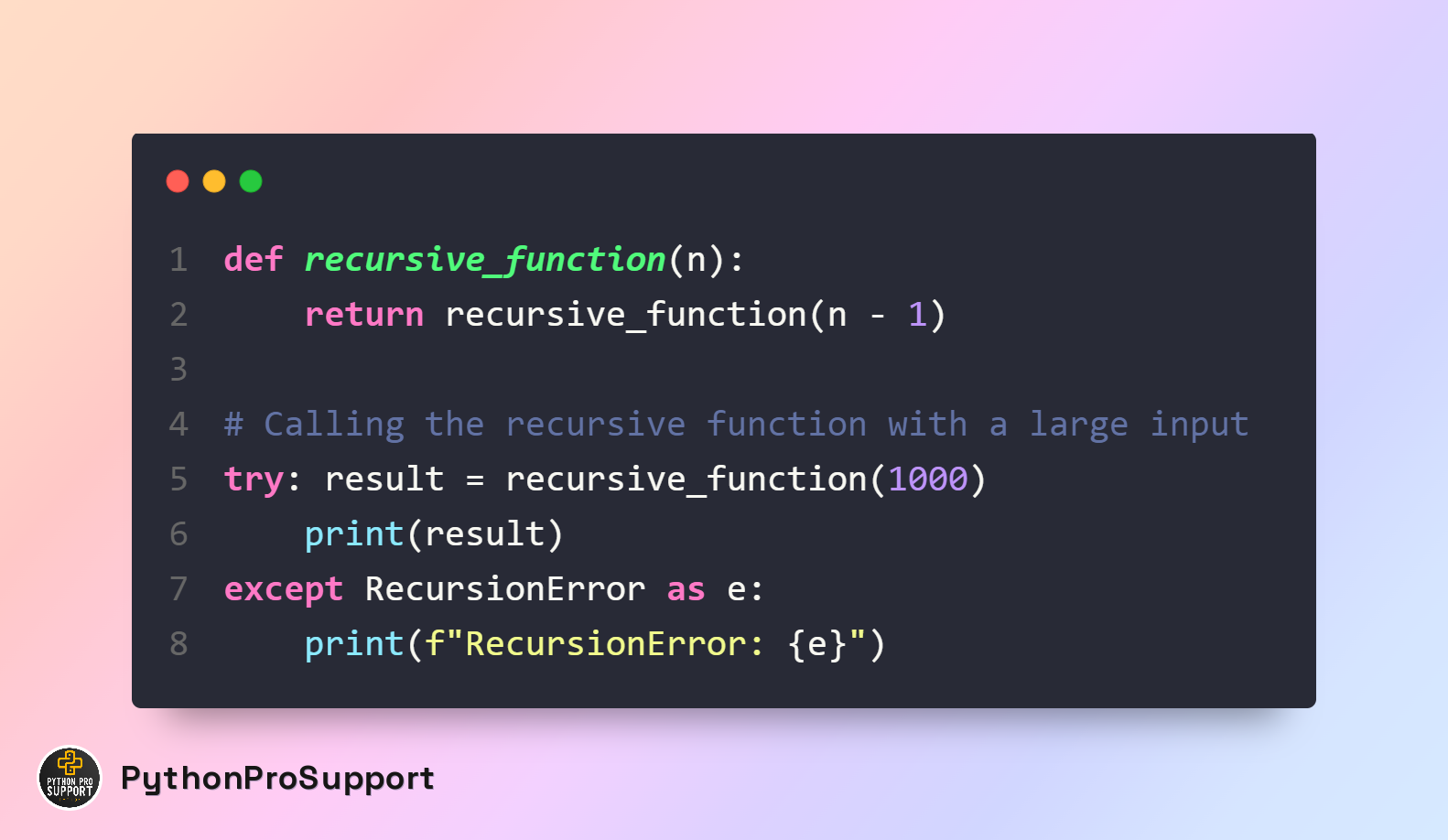Outlines
Strategies for Overcoming RecursionError in Python
Want to recognize a way to deal with RecursionError in Python? As is vital for traditional complex writing. To examine Python programming, not unusual responsibilities are used as effective equipment (methods) to solve complicated issues via breaking them down into one-of-a-kind classes
However, recursive algorithms aren’t without obstacles, and not unusual task builders face is RecursionError. This blunder takes place whilst the depth or range of common calls exceeds the machine limit, causing the program to terminate. This article requires a deeper know-how of how recursion works and the use of effective strategies to address RecursionError.
In this particular guide, I will percentage diverse approaches to prevent such mistakes and first-rate practices to avoid RecursionError in Python. From optimizing algorithms and tail recursion to imposing iterative answers and limiting new release intensity, we look for beneficial techniques that assist programmers in navigating and avoiding the constraints imposed via RecursionError, and offer their ability to jot down efficient and sturdy recursive features in Python.
What is RecursionError in Python?
RecursionError is a specific runtime error in Python that occurs when a function calls itself recursively without finding a base case or termination condition. This error usually occurs when the iteration depth exceeds the system’s default limit for maximum iteration.
Example demonstrating RecursionError:

In this example, the recursive_function is designed to be called repeatedly with decreasing number of arguments (n – 1). However, there are no grounds or circumstances to prevent recidivism. As a result, the function calls itself infinitely, eventually reaching the recursion limit set by the system, resulting in a RecursionError.
Python RecursionError Types with Examples
In Python, RecursionError occurs when a function exceeds the maximum recursion depth set by the system. Here are different types of scenarios leading to RecursionError along with examples:
1. Infinite Recursion: Endless loops unraveling in recursive echoes.
|
1 2 3 4 5 6 7 8 |
def infinite_recursion(): return infinite_recursion() # Calling the function causes an infinite loop of recursive calls try: infinite_recursion() except RecursionError as e: print(f"Infinite RecursionError: {e}") |
2. Missing Base Case: Recursive abyss awaits without a defined escape.
|
1 2 3 4 5 6 7 8 9 |
def missing_base_case(n); if n > 0; return missing_base_case(n. 1) # We need to include a base case to stop the recursion when n reaches a value try; missing_base_case(1000) # We must have a condition to stop the recursion except RecursionError, as e; print(f"RecursionError; Missing base case. {e}") |
3. Deep Recursion: Plunging too far into the recursive depths.
|
1 |
<img class="aligncenter wp-image-869 size-full" src="https://pythonprosupport.com/wp-content/uploads/2023/12/RecursionError-in-Python-fixing.png" alt="RecursionError in Python fixing" width="1536" height="1158" /> |
4. Insufficient Base Case Handling: Unattended negative bounds in recursive endeavors.
|
1 2 3 4 5 6 7 8 9 10 11 |
def insufficient_base_case(n): if n &amp;amp;gt; 0: return insufficient_base_case(n - 1) elif n == 0: return # Insufficient handling for cases when n is negative try: insufficient_base_case(1000) # Lack of handling for negative numbers except RecursionError as e: print(f"Insufficient Base Case Handling RecursionError: {e}") |
5. Tail Recursion Optimization: Efficient recursion, paving a path without limit.
|
1 2 3 4 5 6 7 8 9 10 11 12 13 14 15 |
import sys sys.setrecursionlimit(3500) def tail_recursive_func(n, accumulator=0): # Using If else structure if n == 0: return accumulator else: return tail_recursive_func(n - 1, accumulator + n) # Optimized tail-recursive function to prevent RecursionError # Calling a function output = tail_recursive_func(2000) # Show output print(output) |
Recognizing and addressing these scenarios by ensuring a proper base case, optimizing the code, or adjusting the recursion depth can help prevent RecursionError, ensuring the smooth execution of recursive functions in Python.
Best practices to avoid RecursionError
Consider using these best practices to avoid encountering RecursionError in Python when working with recursive functions:
1. Establish the base case:
Make sure your repetitive tasks include a principle—a condition that, if satisfied, stops repetition. This prevents endless frequent calls.
Example:
|
1 2 3 4 5 |
def factorial(n): if n == 0: # Base case: Stop recursion when n reaches 0 return 1 else: return n * factorial(n - 1) |
2. Verify Input Parameters:
Check the input parameters or arguments passed to the recursive function to avoid unexpected values that might lead to infinite recursion.
Example:
|
1 2 3 4 5 |
def sum_natural_numbers(n): if n &amp;amp;amp;lt;= 0: return 0 else: return n + sum_natural_numbers(n - 1) |
3. Optimize the tree iteration:
Rearrange your repetitive tasks to optimize tree regeneration. This requires the direct use of callback results rather than subsequent additional operations.
Example:
|
1 2 3 4 5 |
def tail_recursive(n, accumulator=0): if n == 0: return accumulator else: return tail_recursive(n - 1, accumulator + n) |
4. Depth of reproducibility limits:
If possible, consider using iterative rather than recursive methods for tasks that may exceed the system’s iteration depth limit.
5. Increase the Recursion Limit (with caution):
You can change the maximum recursion depth limit using sys.setrecursionlimit(). However, changing this constraint can affect system performance and should be done with caution.
Example:
|
1 2 |
import sys sys.setrecursionlimit(1500) # Set the recursion limit to 1500 (or an appropriate value) |
By applying these best practices, you can reduce the occurrence of RecursionError in your Python code and ensure the proper performance of recursive functions, making them more efficient and easier to exceed the recursion depth limit.
Your Interested Topics:
Python Functions: A Step-by-Step Beginner’s Guidelines
Addressing IndentationError in Python: Python’s Whitespace Woes
Python Modules Demystified: Essential Elements for New Learners
If you located a useful publish, please share it on social networks inclusive of Facebook, Twitter, and WhatsApp Contacts / Groups to unfold the Python expertise! And consider joining our YouTube channel for video content.
